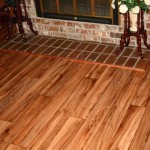How to Install Vinyl Tile Flooring Over Linoleum
Installing vinyl tile flooring over existing linoleum can be a cost-effective and relatively straightforward way to update the appearance of a room. This method avoids the labor-intensive and potentially messy process of removing the old linoleum. However, success hinges on proper preparation and adherence to best practices. This article provides a detailed guide to installing vinyl tile over linoleum, ensuring a durable and aesthetically pleasing result.
Before embarking on this project, it’s crucial to understand the limitations and potential pitfalls. Not all linoleum floors are suitable underlayments for vinyl tile. Furthermore, any existing problems with the linoleum floor, such as moisture damage or unevenness, will likely translate to problems with the new vinyl tile installation. A thorough assessment of the existing floor is therefore the first and most important step.
Assessing the Existing Linoleum Floor
A comprehensive assessment of the linoleum floor involves several key checks. These checks determine the suitability of the existing floor as a subfloor for vinyl tile.
First, inspect the linoleum for signs of moisture damage. Look for discoloration, bubbling, or areas that feel soft or spongy. Moisture can lead to mold growth and degrade the adhesive used to secure the vinyl tiles. If moisture is present, the source must be identified and rectified before proceeding. This may involve addressing leaks, improving ventilation, or installing a moisture barrier.
Second, evaluate the floor's flatness. Use a long level or straight edge to identify any dips, humps, or unevenness. Significant variations in height can cause the vinyl tiles to crack or become uneven over time. Minor imperfections can often be addressed with patching compound, but severe unevenness may necessitate leveling the entire floor or even removing the linoleum altogether.
Third, check the linoleum’s adhesion to the subfloor. Loose or peeling linoleum will not provide a stable base for the vinyl tiles. Attempt to lift the linoleum at the edges and in various spots across the room. If the linoleum is easily detached, it needs to be properly secured. Consider re-gluing loose sections with a suitable adhesive or, if the adhesion is generally poor, removing the linoleum entirely.
Fourth, consider the linoleum's composition and age. Older linoleum, particularly that containing asbestos, poses health risks if disturbed. If you suspect your linoleum contains asbestos, it is crucial to have it professionally tested and, if necessary, removed by a certified abatement contractor. Disturbing asbestos-containing materials can release harmful fibers into the air.
Finally, clean the linoleum floor thoroughly. Remove any dirt, debris, wax, or grease. A clean surface is essential for proper adhesion of the vinyl tiles. Use a mild detergent and water, followed by a thorough rinsing and drying. Avoid harsh chemicals that could damage the linoleum or interfere with the adhesive.
Preparing the Linoleum Surface
Assuming the existing linoleum floor is deemed suitable, the next step is preparing the surface to ensure proper adhesion of the vinyl tiles. This involves cleaning, patching, and potentially priming the floor.
Deep cleaning is paramount. Even if the floor appeared clean initially, it likely harbors microscopic contaminants that can compromise adhesion. Use a commercial floor cleaner specifically designed for linoleum. Follow the manufacturer's instructions carefully. Pay particular attention to areas that are frequently exposed to spills or foot traffic. After cleaning, rinse the floor thoroughly with clean water to remove any residual cleaner.
Address any imperfections in the linoleum surface. Small holes, cracks, or gouges should be filled with a patching compound designed for flooring applications. Apply the compound according to the manufacturer's instructions, ensuring it is flush with the surrounding surface. Allow the patching compound to dry and harden completely before proceeding. Sand the patched areas smooth with fine-grit sandpaper to eliminate any bumps or ridges.
Consider applying a primer designed for use with vinyl tile adhesives. Primers enhance adhesion and create a more uniform surface for the adhesive to bond to. Choose a primer that is compatible with both the linoleum and the vinyl tile adhesive. Apply the primer according to the manufacturer's instructions, typically using a paint roller or brush. Allow the primer to dry completely before applying the adhesive. In some cases, self-adhesive vinyl tiles may not require a primer, but consulting the manufacturer’s recommendations is still advisable.
For older linoleum floors, it may be beneficial to apply a skim coat of self-leveling compound. This creates a smooth, even surface that minimizes imperfections and ensures proper adhesion. Apply the self-leveling compound according to the manufacturer's instructions. This usually involves mixing the compound with water and pouring it onto the floor. Use a gauge rake to spread the compound evenly and remove any air bubbles. Allow the compound to dry and harden completely before proceeding.
Installing the Vinyl Tile Flooring
With the linoleum surface properly prepared, the final step is installing the vinyl tile flooring. Careful planning and attention to detail are essential for achieving a professional-looking result.
Start by measuring the room and determining the layout of the tiles. Find the center of the room by snapping chalk lines across the diagonals. The intersection of these lines marks the center point. Lay out a row of tiles along each chalk line, dry-fitting them to determine the need for any cuts. Adjust the starting point as needed to ensure that the border tiles are of a reasonable size and that the layout is symmetrical.
Apply the adhesive according to the manufacturer's instructions. Use a notched trowel to spread the adhesive evenly across a small area, typically a few rows of tiles at a time. The size of the notched trowel will depend on the type of adhesive and the recommendations of the vinyl tile manufacturer. Avoid applying too much adhesive, as this can cause the tiles to slide or become difficult to align. Similarly, avoid applying too little adhesive, as this can result in poor adhesion and potential tile movement.
Position the first tile carefully at the intersection of the chalk lines. Press it firmly into the adhesive, ensuring it is properly aligned. Continue laying the tiles row by row, working outwards from the center. Use spacers to maintain consistent grout lines between the tiles. Press each tile firmly into the adhesive, using a roller or hand roller to ensure good contact. Remove any excess adhesive from the surface of the tiles with a damp cloth.
When you reach the walls, you will need to cut the tiles to fit. Measure the space between the last full tile and the wall. Transfer this measurement to the tile to be cut, using a utility knife and a straight edge. Score the tile deeply along the cut line and then snap it along the score. For more complex cuts, such as around pipes or corners, use a jigsaw or other appropriate cutting tool. Ensure the cut edges are clean and smooth before installing the tiles.
After all the tiles have been installed, allow the adhesive to dry completely according to the manufacturer's instructions. This typically takes 24-48 hours. Avoid walking on the floor during this time. Once the adhesive is dry, remove the spacers and apply grout to the grout lines, if applicable. Wipe away any excess grout from the surface of the tiles with a damp sponge. Allow the grout to dry completely before sealing it with a grout sealer.
Following these steps meticulously ensures a well-installed vinyl tile floor over existing linoleum, providing an updated aesthetic and a durable surface for years to come. Remember that adequate preparation is key to a successful outcome and seeking professional advice when in doubt is always a recommended step.

Handy How To Guide For Installing L Stick Tile Over Linoleum

Can You Lay Tile Over Linoleum Rubi Blog Usa

How To Lay Tile Over An Existing Vinyl Floor Today S Homeowner

How To Install Luxury Vinyl Tile Over Linoleum Your Home Renewed

Handy How To Guide For Installing L Stick Tile Over Linoleum

How To Install Ceramic Tile Over Vinyl Flooring

10 Beginner Mistakes Installing Vinyl Plank Flooring

Handy How To Guide For Installing L Stick Tile Over Linoleum

Lvt Flooring Over Existing Tile The Easy Way Vinyl Floor Installation Diy

Average Cost Of Vinyl Flooring Installation In 2024 Forbes Home
Related Posts








